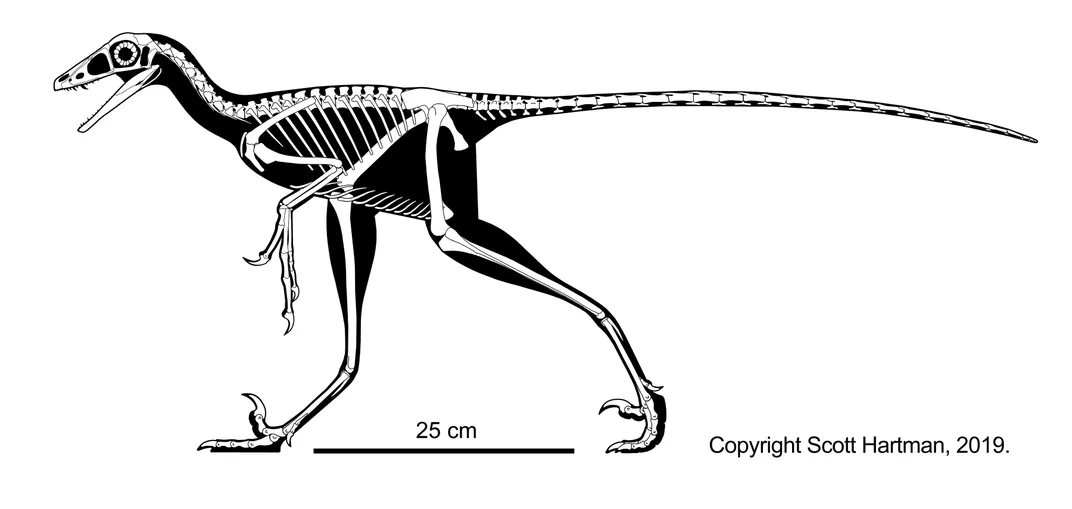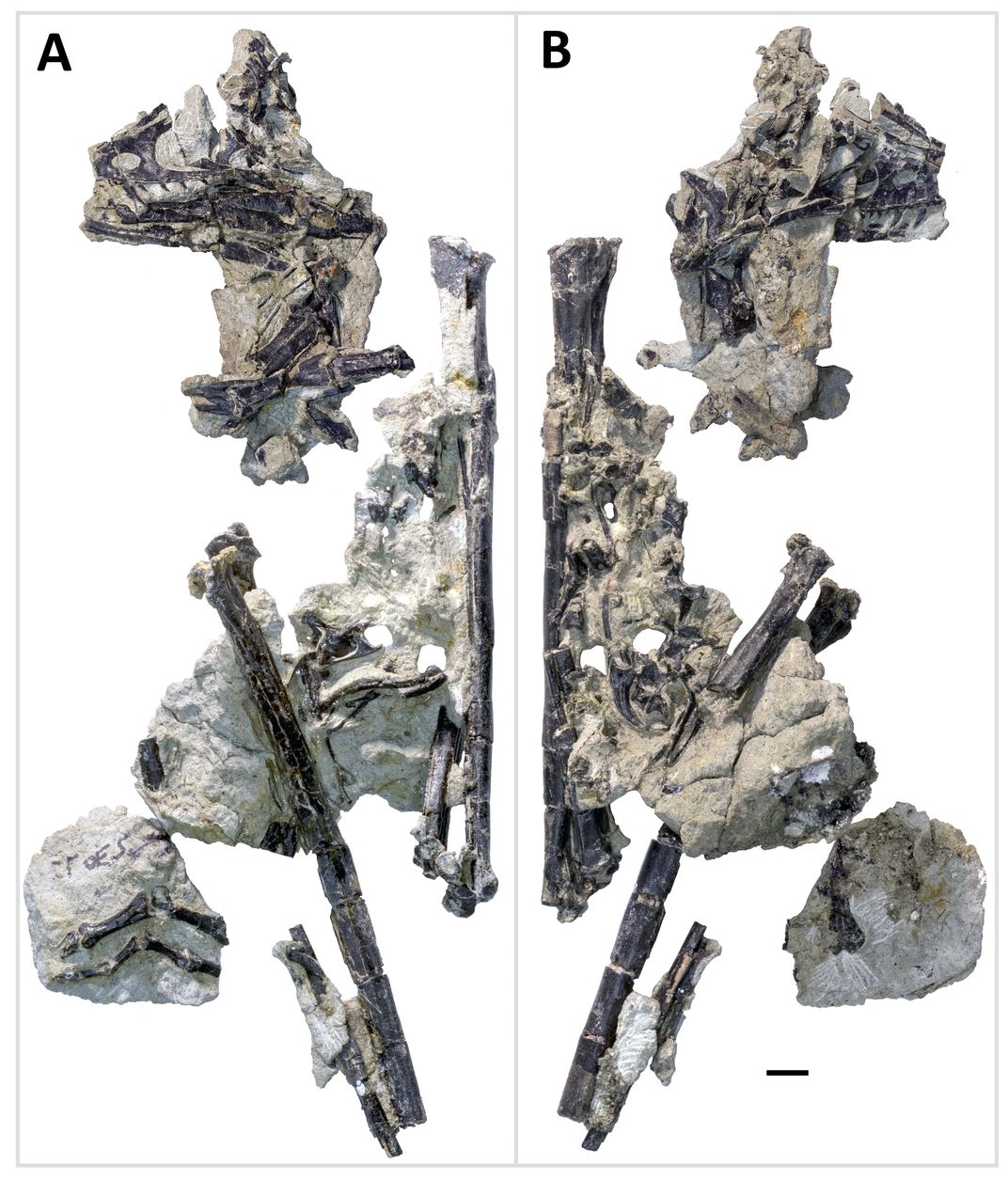Discovery of Raptor-Like Dinosaur Adds a New Wrinkle to the Origin of Birds
A small, 150 million-year-old dinosaur unearthed in Wyoming ran on the ground, but it may have been closely related to some of the first fliers
/https://tf-cmsv2-smithsonianmag-media.s3.amazonaws.com/filer/51/bc/51bc5796-ad3b-497b-b8c4-13ffa6b4baef/aaa.jpg)
No one was expecting to find the little dinosaur.
In 2003, while excavating the enormous bones of a Supersaurus nicknamed “Jimbo,” Wyoming Dinosaur Center paleontologist Bill Wahl spotted something funny. About four inches above the main bone layer, in what was thought to be fossil-free rock that could be chipped away, there lay an accumulation of tiny bones.
At first, Wyoming Dinosaur Center paleontologist Jessica Lippincott says, it seemed like the remains might belong to a flying pterosaur—a non-dinosaur reptile that lived during the same time. But further examination revealed that the bones represent something never seen before: a new species of raptor-like dinosaur, the oldest yet found in North America. “We have the smallest dinosaur and the largest dinosaur found in Wyoming, both in the same quarry,” Lippincott says.
Those bones, representing a partial skeleton, were used to name the new dinosaur Hesperornithoides miessleri today in the journal PeerJ. Described by University of Wisconsin-Madison paleontologist and artist Scott Hartman and colleagues, this dinosaur is categorized as an early member of a group of svelte, small, sickle-clawed dinosaurs known to experts as troodontids. These were raptor-like dinosaurs related to the group that contains more famous carnivores like Velociraptor, as well as the forerunners of birds.

Found in the roughly 150 million-year-old rock of the western United States’ Morrison Formation, Hesperornithoides adds to a growing theme. Even though big dinosaurs such as Stegosaurus, Allosaurus and Apatosaurus have been known from the Morrison Formation for over a hundred years, experts are only just now filling out the ranks of smaller species that lived at the same time. “Hesperornithoides is a stark reminder to paleontologists that little gems can be found hidden away in these same layers of rock,” says University of Calgary paleontologist Darla Zelenitsky.
Experts have been waiting to hear more about this rare find since its initial discovery. “There have been rumors of this specimen for many years, and a few conference presentations, so paleontologists like me have been anxiously waiting for it,” says University of Edinburgh paleontologist Steve Brusatte.
Back in the Jurassic, Hartman says, “Hesperornithoides lived in a fairly open, semi-wet area with herbaceous plants, but no trees to speak of.” This habitat, combined with details from the dinosaur’s skeleton, indicate that the raptor relative was running along the ground rather than fluttering through the air. But the story is somewhat more complex than that. While Hesperornithoides wasn’t a flier, the dinosaur may represent one of the earliest known forerunners of modern birds, helping to piece together a part of the evolutionary tree that remains incomplete.
From related dinosaurs, Hartman and colleagues are confident that Hesperornithoides was extensively feathered. And in terms of skeletal anatomy, the dinosaur has traits that are associated with the origin of flight in other dinosaurs. Hesperornithoides has a curved wishbone, an important site of muscle attachment for arm muscles that were used for flight in early birds, as well as a particular wrist bone called the semilunate carpal that allowed for bird-like folding of the hand under the arm.
The skeletons of Hesperornithoides and other related species indicate that many of the prerequisites for dinosaurs to take to the air evolved on the ground first. The emerging picture isn’t of straight-line evolution, but rather dinosaurs with aerial abilities evolving multiple times from ancestors who lived on the ground. “Some form of aerial behavior evolved several times in parallel,” Hartman says, a significant concept for experts trying to understand the evolution of flight.
Instead of being exemplars of how early birds evolved flight, iconic species such as Archaeopteryx and Microraptor may represent multiple origins of aerodynamic skills like fluttering or gliding. The new study proposes that birds capable of powered flight evolved independently from other flight-related skills, and likely from a dinosaur closer in form to Hesperornithoides.

“I think it definitely gets us closer to what the forerunners of birds looked like, but not because Hesperornithoides itself was that animal,” Hartman says. Rather, the new fossil indicates that the origin of flying birds may have occurred later than researchers had expected and in a more specific group of dinosaurs.
Other experts are not entirely sure about how Hesperornithoides fits into the greater raptor family tree. It may hop to another branch with future analysis, as there is a great deal of uncertainty regarding how closely related these dinosaur species are to one another, Brusatte says. Birds certainly evolved from dinosaurs like Hesperornithoides, but experts have yet to reach a consensus on which species of ancient raptors are closest to this fascinating evolutionary origin story.
“Maybe Hesperornithoides is the type of animal that birds directly evolved from,” Brusatte says, meaning the dinosaur wasn’t the ancestor of the first birds but gives us a look at that ancestor’s body plan. Or perhaps the dinosaur was one of many bird-like dinosaurs that are near the origin of avians but not direct ancestors. Debate will continue, Brusatte says, but “if birds evolved from a Hesperornithoides-like animal, then that means they probably evolved from running, ground-living animals.”
“Regardless of the exact phylogenetic position of Hesperornithoides among bird relatives, the discovery of a well-preserved specimen from North America that is so close to the ancestry of birds and Jurassic in age is unusual to say the least,” Zelenitsky says. Paleontologists will no doubt be fluttering about this dinosaur for years to come.
/https://tf-cmsv2-smithsonianmag-media.s3.amazonaws.com/accounts/headshot/RileyBlack.png)
/https://tf-cmsv2-smithsonianmag-media.s3.amazonaws.com/accounts/headshot/RileyBlack.png)